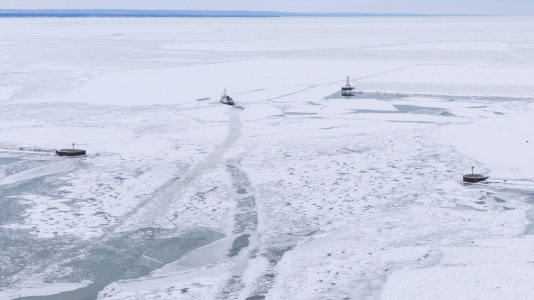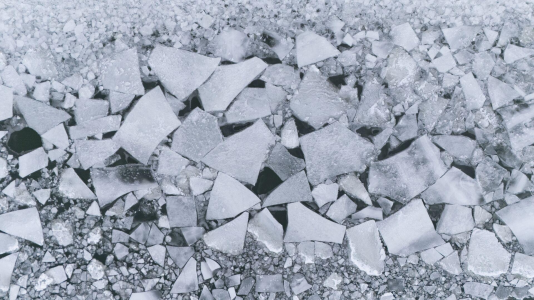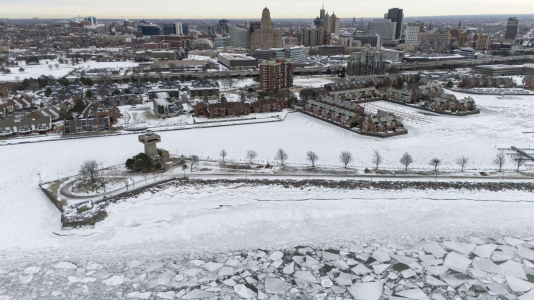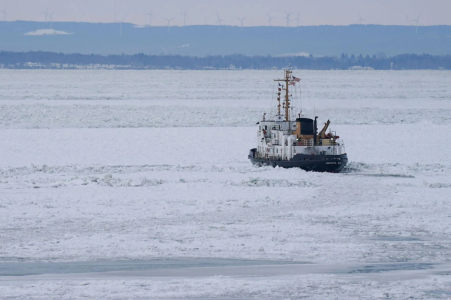
Lake ice and water temperatures show Great Lakes winters are getting shorter
There are about 42 fewer days of wintry weather in the Great Lakes than in 1995, according to a study published in the journal Environmental Research Letters. That is a loss of roughly 14 days per decade, or 1.43 days per year.
It’s a common conversation among longtime Western New York residents: The winters around here aren’t like they used to be.
It’s not nostalgia: New research indicates that winters are getting shorter in the Great Lakes.
Scientists did not arrive at this conclusion by measuring snow accumulation in driveways, though. They measured water temperatures and ice coverage over the chain of vast freshwater lakes, and the numbers they arrived at are significant, especially if you spend January and February dreaming of springtime.
There are about 42 fewer days of wintry weather in the Great Lakes than in 1995, according to a study published in the journal Environmental Research Letters. That is a loss of roughly 14 days per decade, or 1.43 days per year.

An aerial view of ice-covered Buffalo Harbor as the U.S. Coast Guard Cutter Bristol Bay cuts through the ice pack on its way out into Lake Erie. Derek Gee/Buffalo News
The study categorized “winter days” as those with ice cover, or water temperatures less than about 2 degrees Celsius, or 35.6 degrees Fahrenheit.
The loss of winter days means the waters in the lakes are generally getting warmer.
Eric Anderson, the study’s lead author and professor in the Colorado School of Mines civil and environmental engineering department, said the results of the study are not necessarily surprising.
“A lot of studies in the last 10, 20 years have pointed out that summers in the lakes are extending,” he said. “We found that fall and spring are then absorbing winter days, in response to that.”
As fall begins later, so does winter. Then, as spring begins earlier, winter ends earlier, Anderson explained.
Shorter winters also mean less ice cover.

An aerial view of ice floes in Lake Erie off of Erie Basin Marina. Derek Gee/Buffalo News
Prior to 2000, it was normal for Lake Erie to see at least 80% of its surface covered at winter’s peak, according to data from the Great Lakes Environmental Research Laboratory. Now, it’s becoming more common for the lake to have years where less than 40% of it is covered with ice at its peak, the lab’s data show.
As of Jan. 30, about 80% of Lake Erie was covered with ice, the first time it had reached that much ice coverage since 2022, according to the lab.
Anderson noted that the warming waters of the Great Lakes are caused by climate change. The excess burning of fossil fuels to generate power, manufacture goods, produce food and power buildings, in addition to forest deforestation, have caused the Earth’s atmosphere to heat up. Global warming has affected local ecosystems such as Lake Erie, as evidenced by Anderson’s study.

Erie Basin Marina was covered with ice on Thursday, when about 80% of Lake Erie was covered with ice.
It’s becoming more common for the lake to have years where less than 40% of it is covered at its peak. Derek Gee, Buffalo News
The impacts of a shorter winter are varied.
On one hand, there are ecosystem impacts.
For example, some fish rely on ice coverage to protect their eggs, and mayflies emerge from lake sediments when it gets warm enough. Shortening winters could impact how fish, bugs, bacteria and mammals can survive.
Some invasive fish species, such as the alewife and American gizzard shad, thrive in warmer waters, according to Jason Robinson, the state Department of Environmental Conservation’s Lake Erie Fisheries Research Unit leader.
“We’re at record numbers for those fish species, now,” he said.
He noted that, due to their intolerance to cold winters such as the one Lake Erie is currently experiencing, a lot of dead alewife and gizzard shad could wash ashore this spring.
However, the shorter winters have resulted in some surprising fishery impacts, as well.
“We told people for a long time, decades, in fact, that you needed good ice coverage to produce strong walleye year classes,” Robinson said. “And then we’ve been through this decade with virtually no complete ice cover, with record-breaking walleye year classes.”

The U.S. Coast Guard Cutter Bristol Bay carves its way through the Buffalo Harbor Channel as it heads out to ice-covered Lake Erie. Derek Gee, Buffalo News
In Lake Erie, Robinson said it is difficult to pinpoint whether an unusually short winter is solely responsible for impacts on a species.
“It’s a really complicated system, and each event that happens impacts all the species in the system, and all the species in the system interact with each other, so sometimes predicting exactly how they’re going to react is difficult,” he said.
Shorter winters with less ice coverage also have a broader effect outside of the aquatic ecosystems of Lake Erie. These impacts include severe lake-effect snowstorms, lake seiches, ice shoves, high winds and inland flooding, Buffalo Niagara Waterkeeper Executive Director Jill Jedlicka said.
And while there are slightly fewer of them, storms are dumping more snow on the region than ever before, according to a Buffalo News analysis of data from the National Oceanic and Atmospheric Administration. That, in large part, is likely due to Lake Erie’s declining ice coverage, experts said.
“In the last few years alone, reduced ice cover and more frequent and intense storms have resulted in over a billion dollars in damages and impact to our communities and waterfront infrastructure,” Jedlicka said in an emailed statement. “These are real costs and real events that can’t be dismissed or ignored.”
